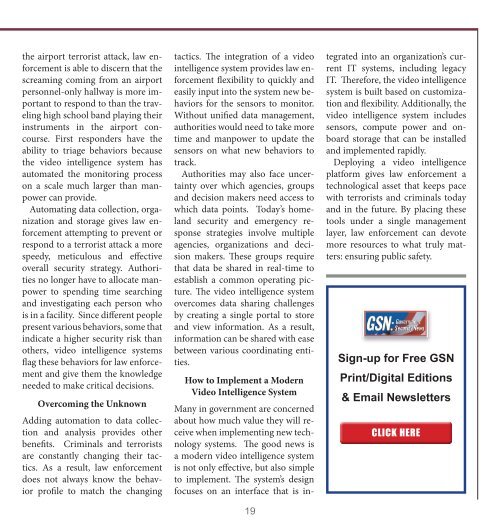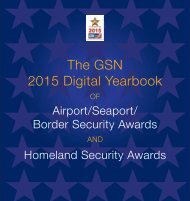GSN January 2016 Digital Edition
Create successful ePaper yourself
Turn your PDF publications into a flip-book with our unique Google optimized e-Paper software.
the airport terrorist attack, law enforcement<br />
is able to discern that the<br />
screaming coming from an airport<br />
personnel-only hallway is more important<br />
to respond to than the traveling<br />
high school band playing their<br />
instruments in the airport concourse.<br />
First responders have the<br />
ability to triage behaviors because<br />
the video intelligence system has<br />
automated the monitoring process<br />
on a scale much larger than manpower<br />
can provide.<br />
Automating data collection, organization<br />
and storage gives law enforcement<br />
attempting to prevent or<br />
respond to a terrorist attack a more<br />
speedy, meticulous and effective<br />
overall security strategy. Authorities<br />
no longer have to allocate manpower<br />
to spending time searching<br />
and investigating each person who<br />
is in a facility. Since different people<br />
present various behaviors, some that<br />
indicate a higher security risk than<br />
others, video intelligence systems<br />
flag these behaviors for law enforcement<br />
and give them the knowledge<br />
needed to make critical decisions.<br />
Overcoming the Unknown<br />
Adding automation to data collection<br />
and analysis provides other<br />
benefits. Criminals and terrorists<br />
are constantly changing their tactics.<br />
As a result, law enforcement<br />
does not always know the behavior<br />
profile to match the changing<br />
tactics. The integration of a video<br />
intelligence system provides law enforcement<br />
flexibility to quickly and<br />
easily input into the system new behaviors<br />
for the sensors to monitor.<br />
Without unified data management,<br />
authorities would need to take more<br />
time and manpower to update the<br />
sensors on what new behaviors to<br />
track.<br />
Authorities may also face uncertainty<br />
over which agencies, groups<br />
and decision makers need access to<br />
which data points. Today’s homeland<br />
security and emergency response<br />
strategies involve multiple<br />
agencies, organizations and decision<br />
makers. These groups require<br />
that data be shared in real-time to<br />
establish a common operating picture.<br />
The video intelligence system<br />
overcomes data sharing challenges<br />
by creating a single portal to store<br />
and view information. As a result,<br />
information can be shared with ease<br />
between various coordinating entities.<br />
How to Implement a Modern<br />
Video Intelligence System<br />
19<br />
Many in government are concerned<br />
about how much value they will receive<br />
when implementing new technology<br />
systems. The good news is<br />
a modern video intelligence system<br />
is not only effective, but also simple<br />
to implement. The system’s design<br />
focuses on an interface that is integrated<br />
into an organization’s current<br />
IT systems, including legacy<br />
IT. Therefore, the video intelligence<br />
system is built based on customization<br />
and flexibility. Additionally, the<br />
video intelligence system includes<br />
sensors, compute power and onboard<br />
storage that can be installed<br />
and implemented rapidly.<br />
Deploying a video intelligence<br />
platform gives law enforcement a<br />
technological asset that keeps pace<br />
with terrorists and criminals today<br />
and in the future. By placing these<br />
tools under a single management<br />
layer, law enforcement can devote<br />
more resources to what truly matters:<br />
ensuring public safety.<br />
Sign-up for Free <strong>GSN</strong><br />
Print/<strong>Digital</strong> <strong>Edition</strong>s<br />
& Email Newsletters<br />
CLICK HERE
















